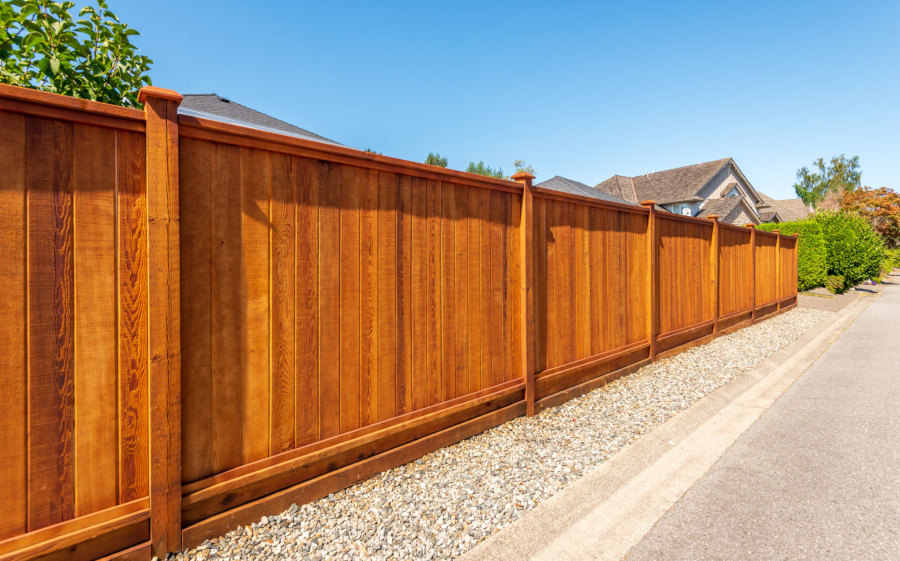How to Select the Right Fencing Discoloration for Your Residential Property
When it comes to enhancing the look and resilience of your property's fence, choosing the appropriate stain is a crucial decision that needs cautious factor to consider. Just how can you make sure that you choose the perfect fence discolor that aligns with your property's style and maintenance needs?
Recognizing Timber Kind
To select the proper fencing stain, it is vital to have a detailed understanding of the different types of timber commonly used for secure fencing. The selection of timber plays a vital function in determining the durability and overall aesthetics of the fence. Cedar is a preferred selection as a result of its all-natural resistance to degeneration and bugs, making it a resilient option for outside frameworks. Pine is an additional typical wood utilized in secure fencing, recognized for its cost and simplicity of discoloration. However, yearn is more prone to bending and decomposing compared to cedar. Redwood is a premium choice recognized for its striking look and natural resilience, though it comes with a higher cost. When choosing a fence discolor, it is very important to think about the sort of timber being made use of to make sure compatibility and optimal protection. Understanding the characteristics of various timber types will help you make a notified decision when it concerns picking the right fencing stain for your building - Fence Staining.
Choosing the Right Shade
Selecting an appropriate color for your fencing stain is a vital choice that dramatically influences the total aesthetic allure of your residential or commercial property. Lighter colors such as whites or light grays can make a fence appear bigger and include a touch of style to your residential property. Eventually, the right shade choice will certainly enhance the appeal of your fence and boost the overall aesthetic appeal of your home.

Considering Transparency Degrees
When picking the appropriate color for your fence stain, an additional essential facet to consider is the level of transparency that will best suit your residential or commercial property's visual and upkeep demands. Openness degrees in fencing discolorations usually drop right into 3 groups: transparent, semi-transparent, and strong. Consider the level of exposure your fence faces, the preferred upkeep frequency, and the aesthetic you desire to attain when selecting the appropriate openness level for your fencing tarnish.
Reviewing Maintenance Requirements
Thinking about the durability and upkeep of your fencing, evaluating the maintenance needs is essential in determining the most ideal fencing discolor for your property. learn this here now The level of upkeep needed for your fence can differ depending upon elements such as the kind of wood, weather in your area, and your individual preferences.
When reviewing maintenance needs, it is important to consider the durability of the fencing tarnish. Some stains require more frequent reapplication than others, so choosing a tarnish with a longer life expectancy can help in reducing the general upkeep needs of your fencing (Fence Staining). Furthermore, elements such as resistance to UV rays, water, and mildew can affect just how often you need to re-stain your fencing

Testing Examples Prior To Application
Prior to applying any type of fencing tarnish, it is advisable to perform example examinations to ensure compatibility with the timber and wanted visual result (Fence Staining Nashville TN). Evaluating samples allows you to evaluate how the discolor will engage with the specific sort of wood used in your fence, as various timbers can absorb spots in a different way. To start, choose a tiny inconspicuous area of the fencing to use the stain samples. It is recommended to check multiple tarnish alternatives on this area to contrast shades and finishes. Think about how the discolor looks when dry, as it might appear different from its damp application. In addition, observe exactly how the tarnish complements the existing aspects in your outside room, such as landscape design or the shade of your home. Bear in mind of just how the tarnish holds up to climate condition like sunshine and moisture. By examining examples prior to complete application, you can make an enlightened decision that boosts the overall appearance of your home while protecting the timber efficiently.
Conclusion
In verdict, picking the proper fencing discolor for your property involves recognizing the timber kind, choosing the ideal shade, considering openness degrees, assessing upkeep requirements, and screening samples prior to application (Fence Staining). By taking these variables into consideration, you can make certain that your fence tarnish enhances your residential property while providing the needed security and longevity. Make a notified choice to boost the appearance and longevity of your fence